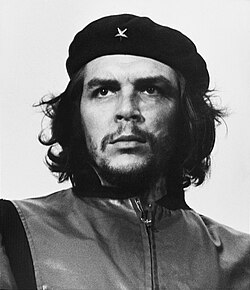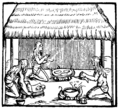
Back بوابة:كوبا Arabic প্রবেশদ্বার:কিউবা Bengali/Bangla Portal:Cuba Spanish Portail:Cuba French Portale:Cuba Italian Portal:Cuba Portuguese Портал:Куба Russian باب:کیوبا Urdu
Welcome to the Cuba Portal
Cuba, officially the Republic of Cuba, is an island country, comprising the island of Cuba (largest island), Isla de la Juventud, and 4,195 islands, islets and cays surrounding the main island. It is located where the northern Caribbean Sea, Gulf of Mexico, and Atlantic Ocean meet. Cuba is located east of the Yucatán Peninsula (Mexico), south of both Florida and the Bahamas, west of Hispaniola (Haiti/Dominican Republic), and north of Jamaica and the Cayman Islands. Havana is the largest city and capital. Cuba is the third-most populous country in the Caribbean after Haiti and the Dominican Republic, with about 10 million inhabitants. It is the largest country in the Caribbean by area. Cuba is a socialist state, in which the role of the Communist Party is enshrined in the Constitution. Cuba has an authoritarian government where political opposition is not permitted. Censorship is extensive and independent journalism is repressed; Reporters Without Borders has characterized Cuba as one of the worst countries for press freedom. Culturally, Cuba is considered part of Latin America. Cuba is a founding member of the United Nations, G77, Non-Aligned Movement, Organisation of African, Caribbean and Pacific States, ALBA, and Organization of American States. It has one of the world's few planned economies, and its economy is dominated by tourism and the exports of skilled labor, sugar, tobacco, and coffee. Cuba has historically—before and during communist rule—performed better than other countries in the region on several socioeconomic indicators, such as literacy, infant mortality and life expectancy. Cuba has a universal health care system which provides free medical treatment to all Cuban citizens, although challenges include low salaries for doctors, poor facilities, poor provision of equipment, and the frequent absence of essential drugs. A 2023 study by the Cuban Observatory of Human Rights (OCDH), estimated 88% of the population is living in extreme poverty. The traditional diet is of international concern due to micronutrient deficiencies and lack of diversity. As highlighted by the World Food Programme (WFP) of the United Nations, rationed food meets only a fraction of daily nutritional needs for many Cubans, leading to health issues. (Full article...) Selected article - Appearances of Argentine Marxist revolutionary Che Guevara (1928–1967) in popular culture are common throughout the world. Although during his lifetime he was a highly politicized and controversial figure, in death his stylized image has been transformed into a worldwide emblem for an array of causes, representing a complex mesh of sometimes conflicting narratives. Che Guevara's image is viewed as everything from an inspirational icon of revolution, to a retro and vintage logo. Most commonly he is represented by a facial caricature originally by Irish artist Jim Fitzpatrick and based on Alberto Korda's famous 1960 photograph titled Guerrillero Heroico. The evocative simulacra abbreviation of the photographic portrait allowed for easy reproduction and instant recognizability across various uses. For many around the world, Che has become a generic symbol of the underdog, the idealist, the iconoclast, or the martyr. He has become, as author Michael Casey notes in Che's Afterlife: The Legacy of an Image, "the quintessential postmodern icon signifying anything to anyone and everything to everyone." Che Guevara's likeness has undergone continual apotheosis while being weaved throughout the public consciousness in a variety of ways. From being viewed as a "Saintly Christ-like" figure by the rural poor in Bolivia where he was executed, to being viewed as an idealistic insignia for youth, longing for a vague sense of rebellion. His likeness can also be seen on posters, hats, key chains, mouse pads, hoodies, beanies, flags, berets, backpacks, bandannas, belt buckles, wallets, watches, wall clocks, Zippo lighters, pocket flasks, bikinis, personal tattoos, and most commonly T-shirts. Meanwhile, his life story can be found in an array of films, documentaries, plays, and songs of tribute. Throughout television, music, books, magazines, and even corporate advertisements, Che's visage is an ever-present political and apolitical emblem that has been endlessly mutated, transformed, and morphed over the last fifty years of visual popular culture. This allows Che to operate as "both a fashionable de-politicized logo, as well as a potent anti-establishment symbol used by a wide spectrum of human rights movements and individuals affirming their own liberation." (Full article...) General imagesThe following are images from various Cuba-related articles on Wikipedia.
Did you know (auto-generated)
Entries here consist of Good and Featured articles, which meet a core set of high editorial standards.
The 1999 Baltimore Orioles – Cuba national baseball team exhibition series consisted of two exhibition games played between the Baltimore Orioles of Major League Baseball (MLB) and the Cuba national baseball team on March 28 and May 3, 1999. The first game took place in Havana, while the second was held in Baltimore. This series marked the first time that the Cuba national team had faced a squad composed solely of major league players and the close of the hiatus since 1959 that an MLB team played in Cuba. In the 1990s, Orioles' owner Peter Angelos lobbied the United States federal government to gain permission to hold this series for three years. Various politicians, including members of the United States House of Representatives, opposed the idea and attempted to block the series. Eventually, Angelos secured the approval in 1999, after a change in United States foreign policy to Cuba under President Bill Clinton, which eased travel restrictions and increased cultural exchange. (Full article...) Selected biography - Bartolomé Maximiliano Moré Gutiérrez (24 August 1919 – 19 February 1963), better known as Benny Moré (also spelled Beny Moré), was a Cuban singer, bandleader and songwriter. Due to his fluid tenor voice and his great expressivity, he was known variously as "El Bárbaro del Ritmo" and "El Sonero Mayor". Moré was a master of the soneo – the art of vocal improvisation in son cubano – and many of his tunes developed this way. He often took part in controversias (vocal duels) with other singers, including Cheo Marquetti and Joseíto Fernández. Apart from son cubano, Moré was a popular singer of guarachas, cha cha cha, mambo, son montuno, and boleros. Moré started his career with the Trío Matamoros in the 1940s and after a tour in Mexico he decided to stay in the country. Both Moré and dancer Ninón Sevilla made their cinematic debut in 1946's Carita de cielo, but Moré focused on his music career. In the late 1940s, he sang guaracha-mambos with Pérez Prado, achieving great success. Moré returned to Cuba in 1952 and worked with Bebo Valdés and Ernesto Duarte. In 1953, he formed the Banda Gigante, which became one of the leading Cuban big bands of the 1950s. He suffered from alcoholism and died of liver cirrhosis in 1963 at the age of 43. (Full article...) Selected picture Tobacco field in Pinar del Rio
More did you know -
TopicsCategoriesQuote of the day
Economist Marta Beatriz Roque after organizing the Assembly for the Promotion of Civil Society in Cuba, a rally calling for political change on the island. Things you can doWikipedia's maxim is that anyone can edit. If you are interested in Cuba and have useful information that would form a new article or would enhance an existing article, please feel free to take part. Here are some tasks you can do to help with WikiProject Cuba: Task list
Related portalsWikiProjects
Recognized contentAssociated WikimediaThe following Wikimedia Foundation sister projects provide more on this subject:
More portalsDiscover Wikipedia using portals
| |||||||||
© MMXXIII Rich X Search. We shall prevail. All rights reserved. Rich X Search































































